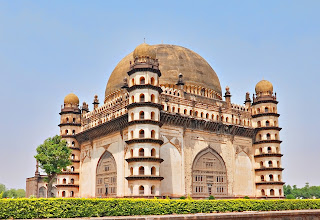Karnataka Rajyotsav Day.
It was on this date, 1st November, 1956, that a new state, Mysore, was born out of a divided Kannada speaking people, who were until then torn between different provinces, that the colonial rulers had put them under. On this day in 1956, courtesy the recommendations of a Committee constituted by Government of India, all the Kannada speaking people were brought together to form the Mysore state, which later became Karnataka State in 1973. The genesis for the reorganization and formation of states on linguistic lines goes back to the beginning of the 1950, when Potti Sreeramulu, a freedom fighter, anointed his fast unto death agitation demanding formation of the state of Andhra Pradesh, based on the Telugu language.
Karnataka is resplendent with world renowned architecture evidenced under the rule of different kingdoms, be it the mighty Chalukyas, the Hoysala, Vijaynagar, Adilshahi, Wodeyars, the Rashtrakutas. It is home to the largest number of the majestic Tigers, Elephants and is a land of Sandalwood and coffee. The rich Kannada literature has helped eight of the scholars to be bestowed with the highest literary award - the Jnanpith award. It is dubbed the silicon valley of India, whose strength created that fear even for Barack Obama, who spoke of people of Buffalo loosing jobs to Bangaloreans, thus making the word Bangalored enter into the lexicon of the English dictionary.
The formation of states on linguistic basis started with the struggle and agitation by the Telugu-speaking people, in the begining of 1950s, who wanted a separate state of their own. Unfortunately the Madras State led by C Rajagopalachari, was not particularly sympathetic to this demand. Pandit Nehru was swayed by the sentiments and opinion of Rajagopalachari and therefore he too was not very sympathetic to the demands of the Telugu speaking people. This led to an agitation, which was spearheaded by Potti Sreeramulu, who started that quintessential Gandhian style of satyagraha - fast unto death - on 19 October, 1952. The then prime minister, Jawaharlal Nehru, assured his support for the creation of Andhra Pradesh and requested Potti Sreeramulu to end his fast. But since there was no written commitment nor was a formal public statement made to this effect by Nehru, Sreeramulu continued with his fast. This led to the spread of agitation in the Telugu speaking region of the Madras state and resulted in public unrest. On that eventful day - 15 December 1952 - Sreeramulu died after about 58 days of his fasting. His death resulted in widespread rioting and violence in many regions in Andhra. A few people were killed in firing by the police. Protests continued and when things seem to take uglier turn, on 29 December, Pandit Nehru announced his decision to form a separate Andhra state on linguistic basis. Accordingly, on 1 October, 1953, the Andhra State was formed with its capital at Kurnool, near to my native place Raichur.
The formation of Andhra Pradesh led to the reorganisation of the Indian states on the basis of languages. In August 1956, Parliament enacted the States Reorganisation Act, which called for states to be redrawn along linguistic lines by November 1 of that year. And one of the states to be formed on the basis on this Act was the state of Mysore, which was formed on 1st November, 1956 that later became the state of Karnataka in 1973. Until 1956, the states in India had largely retained the political boundaries left by the British. The state of Mysore was formed out of four different parts of India, which had majorly the Kannada speaking population namely ; - Mysuru Karnataka, Mumbai Karnataka, Kalyan Karnataka and parts of Madras Presidency. The States Reorganisation Act of 1956, which was based on linguistic division has enabled people to nurture and promote their language and their respective culture in which the language is inextricably intertwined with culture.
Some of the prominent leading lights of the state of Karnataka include Ranna, Pampa, Basavaveshwara, Allama Prabhu, Akkamahadevi, Sarvgna, Shishunala Sharif, Kuvempu, Bendre, Shivraam Karanth, Masti, Gokak, Karnad in literature. Much before the first war of Independence waged by the legendary Rani Jhansi, Kittur Channamma in Karnataka had blown the bugle of freedom from the British and was helped by her strong man Sangolli Rayanana.
https://khened.blogspot.com/2019/10/sangolli-rayanna-forgotten-freedom.html
Anubhava Mantapa was one of the foremost democratic parliamentary style of governance, which began in Karnataka during the 12th century, much before what we now know as parliamentary democracies began anywhere in the world and this was led by Basaveshwara, a remarkable visionary.
https://khened.blogspot.com/2020/04/basava-jayanti-birth-anniversary-of.html
Here is another blogpost on the majestic Ibrahim Roza : https://khened.blogspot.com/2020/04/the-majesty-of-ibrahim-rauza-monument.html
A birds eye view and a tapestry of the state and its vibrant culture can be seen in the accompanying visuals, courtesy Wiki Commons.
Wishing you all a very happy Karnataka Rajyotsava Day.





















No comments:
Post a Comment